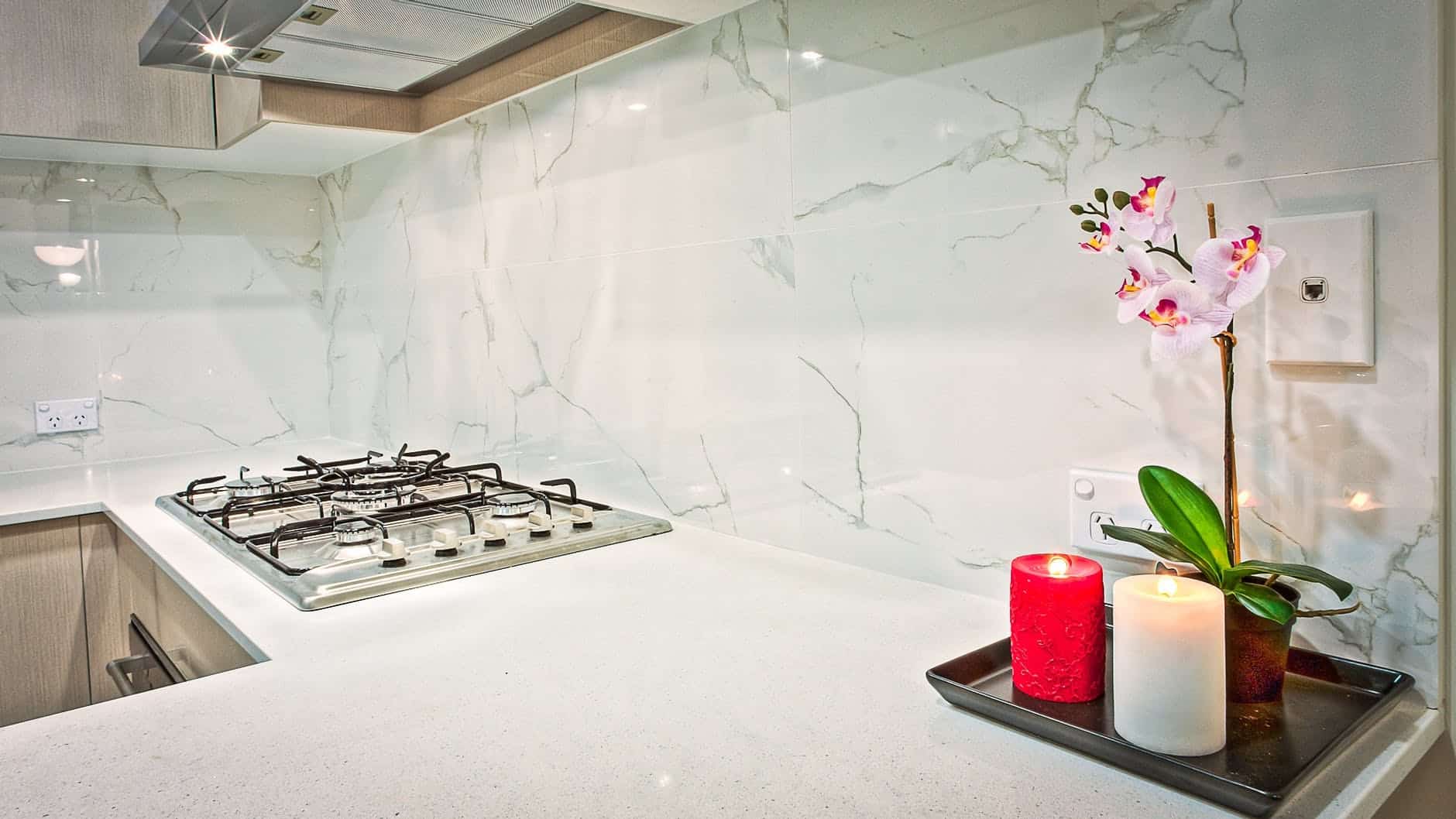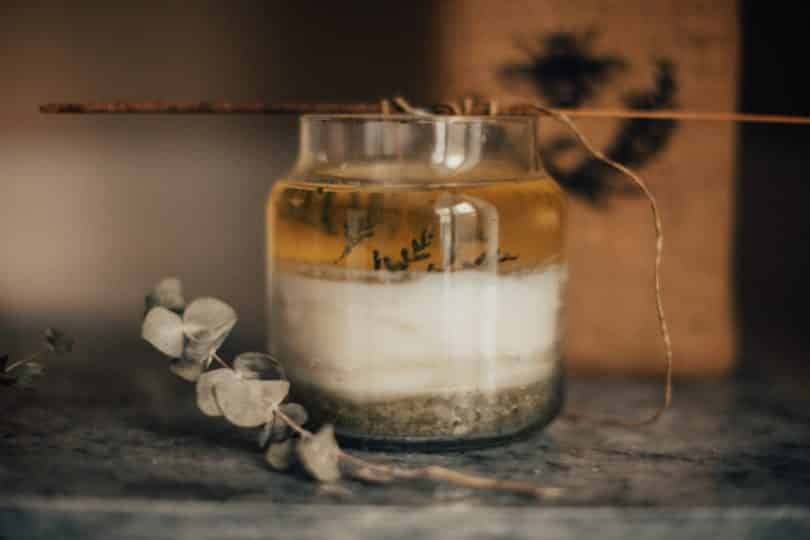Whether you want to skip the candle making kits for some better-quality equipment or are just taking inventory of what you already have, we’ve put together this list of candle making equipment to help you get started.

Candle Making Equipment
Below we’ll talk about the bare minimum of what you need to get started, as well as some of the extra upgrades to help make things easier. Don’t feel like you have to get everything! Just buy what you need to get started.
Thermometers
Especially when you’re working with essential oils and fragrance oils that have a lower flashpoint, it’s important to be able to accurately and quickly tell the temperature of your wax.
You’ll want to find a good thermometer that lets you quickly (and safely!) tell the temperature. A meat or candy thermometer works perfectly fine, but you’ll want to be careful that they don’t slip in if they don’t come with a clip. (Frying thermometers usually come with a clip.)
Glass thermometers work if you can’t get anything else, but I generally don’t recommend them. Cheaper glass thermometers are liable to break when they’re exposed to the high temperatures you’ll be working with.
The best thermometer is an infrared thermometer, as they allow you to tell temperatures at a distance. Once you get ahold of one of these, you’ll never go back to regular thermometers. They’re just as accurate, often quicker, and you don’t have to deal with cleaning off wax.
Pots and Heat Sources
Next, you’ll want to find something to melt and pour your wax with.
At the very least, wax needs a double boiler to melt. (I used a giant metal mixing bowl on top of a pot filled a quarter of the way with boiling water—not exactly the safest thing!) If you don’t have a double boiler, a thick glass measuring cup in a boiling pot of water works just as well.
Ideally, you want your hands to be free to work on other things and you don’t want to have to watch it too much, especially if you’re trying to quickly make candles in bulk. Do yourself a favor and skip the metal bowl.
You’ll also want to get something for pouring. Your melting and pouring containers might be the same thing at the start, but eventually, you’ll want to invest in a good pouring pot. 4-pound aluminum containers work great and easily fit on most heating elements.
Don’t make the mistake of getting frothing pitchers, which usually have metal handles. Not great when you’re pouring incredibly hot wax—heat can transfer to the handle fairly quickly. You’ll want to make sure you get one with a heat-resistant handle.
Measuring Scales
Affordable measuring scales are easy to come by. You’ll want something that’s accurate, with little deviation, and weighs up to about 10 kg. Pretty much any normal baking scale will work just fine for candle making.
Wick Holders
It’s hard to go wrong with most wick holders—the only thing you really want to make sure of is whether or not they’re large enough for multi-wick candles if you plan on making larger candles.
Otherwise, you can look for the cheapest options. Wooden candle wick holders tend to be a little more affordable and you can usually find packs of 100 to 200 for just a little over five dollars.
Mixing Utensils
You don’t need anything fancy here. Drink mixing spoons work well—the longer, the better. I’ve got some giant metal chopsticks that I still use for mixing. Not quite as practical, but they get the job done.
Silicone Trivet Mats
If you’re in the habit of setting stuff on the counter or don’t have the space to keep things on the stove, get a pack of silicone trivet mats to help keep things protected from heat.
Candle Making Supplies
Next, you’ll want to find supplies to make your candles with. We’ve covered some of this in previous articles, so you can click through to the posts for more information.
Wax
Wax is the most important part of your candle. It affects everything from how long candles last to how well they distribute scent, so you don’t want to skip out on getting the best wax for your project!
Paraffin wax or wax blends with paraffin in them are still the most common type of wax to use in candles. However, if you’re looking for something that burns slower, cleaner, and is just as sturdy, beeswax is a great alternative.
There are also plenty of other great options for more natural alternatives, like soy, coconut, palm, and other types of waxes. It’s a little trickier to get a great scent throw with these, but with the right combination, they make a decent alternative to paraffin waxes.
More information on how to choose the best wax for your candle here.
Fragrances
There’s a lot of debate surrounding what to add to candles, especially if you burn them frequently. If you find that you’re sensitive to most fragrance oils in candles and want to try a more natural alternative, essential oils can make a great addition to your candles.
It takes a lot of trial and error, but you can get some amazing scents with essential oils. However, it’s nothing like you can with some of the lab-created scents you get from high-quality fragrance oils.
You definitely have to reset your expectations if you’re used to strong candles that smell like freshly baked goods or your favorite coffee shop! But the same is true for a lot of fragrance oils—it’s hard to find a blend that matches your favorite essential oil blend. Some scents just can’t be replicated easily.
Here’s some more information on choosing fragrances for your candles, whether you decide to go with fragrance oils or essential oils.
| Preview | Product | Price | |
|---|---|---|---|

|
Eternal Essence Oils Freshly Baked Set of 6 Premium Fragrance Oils - Includes Blueberry Pancakes,... | $22.95 | Buy on Amazon |
Containers
There are tons of beautiful containers for making candles. In general, thick glass that distributes heat evenly are the best choice. You can use candle tins, but you’ll want to make sure you have something for them to sit on when they start burning lower.
Here are some of our favorites:
Wicks
Cotton wicks are still pretty standard for candles, but things like hemp and wooden candle wicks are gaining popularity.
Wooden wicks are especially unique. They offer a hotter, cleaner burn and sound just like a crackling fireplace!
Know a friend who would love to join you in your candle-making endeavors? Share this post with them!
You can also check out some of our other candle making articles:







































